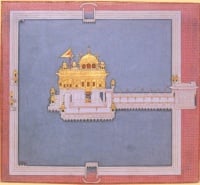Template:AOW263: Difference between revisions
Hari singh (talk | contribs) No edit summary |
Hari singh (talk | contribs) No edit summary |
||
| Line 1: | Line 1: | ||
{{aowh|[[Sikh Gurdwaras Act]]}} | {{aowh|[[Sikh Gurdwaras Act]]}} | ||
{{ | {{p2|File:Harimandir Sahib Kapany collection.jpg|[[Harmandir Sahib]]}} | ||
'''[[Sikh Gurdwaras Act, 1925]]''' was a piece of legislation passed by the [[Punjab]] Legislative Council on '''9 July 1925''' which marked the culmination of the struggle of the [[Sikh]] people from 1920-1925 to wrest control of their places of worship from the [[mahant]]s or priests into whose hands the [[Gurdwara]]s had passed during the eighteenth-century when the [[Khalsa]] were driven from their homes to seek safety in remote hills and deserts. | '''[[Sikh Gurdwaras Act, 1925]]''' was a piece of legislation passed by the [[Punjab]] Legislative Council on '''9 July 1925''' which marked the culmination of the struggle of the [[Sikh]] people from 1920-1925 to wrest control of their places of worship from the [[mahant]]s or priests into whose hands the [[Gurdwara]]s had passed during the eighteenth-century when the [[Khalsa]] were driven from their homes to seek safety in remote hills and deserts. | ||
| Line 6: | Line 6: | ||
When they later established their sway in [[Punjab]], the Sikhs rebuilt their shrines endowing them with large [[jagir]]s and estates. The management, however, remained with the priests, belonging mainly to the [[Udasi]] sect, who, after the advent of the British in 1849, began to consider the shrines and lands attached to them as their own personal properties and to appropriating the income accruing from them to their private use. | When they later established their sway in [[Punjab]], the Sikhs rebuilt their shrines endowing them with large [[jagir]]s and estates. The management, however, remained with the priests, belonging mainly to the [[Udasi]] sect, who, after the advent of the British in 1849, began to consider the shrines and lands attached to them as their own personal properties and to appropriating the income accruing from them to their private use. | ||
Some of them alienated or sold [[gurdwara]] properties at will. They had introduced ceremonies which were distasteful to orthodox [[Sikh]]s. Besides, there were complaints of immorality against them. All these factors gave rise to what is known as the Gurdwara Reform movement during which Sikhs had to court jail on a large scale and suffer atrocity and death to get control of key Sikh shrines. {{aowf|Sikh Gurdwaras Act}} | Some of them alienated or sold [[gurdwara]] properties at will. They had introduced ceremonies which were distasteful to orthodox [[Sikh]]s. <!---------Besides, there were complaints of immorality against them. All these factors gave rise to what is known as the Gurdwara Reform movement during which Sikhs had to court jail on a large scale and suffer atrocity and death to get control of key Sikh shrines.------> {{aowf|Sikh Gurdwaras Act}} | ||
Revision as of 17:30, 7 July 2009
Sikh Gurdwaras Act, 1925 was a piece of legislation passed by the Punjab Legislative Council on 9 July 1925 which marked the culmination of the struggle of the Sikh people from 1920-1925 to wrest control of their places of worship from the mahants or priests into whose hands the Gurdwaras had passed during the eighteenth-century when the Khalsa were driven from their homes to seek safety in remote hills and deserts.
When they later established their sway in Punjab, the Sikhs rebuilt their shrines endowing them with large jagirs and estates. The management, however, remained with the priests, belonging mainly to the Udasi sect, who, after the advent of the British in 1849, began to consider the shrines and lands attached to them as their own personal properties and to appropriating the income accruing from them to their private use.
Some of them alienated or sold gurdwara properties at will. They had introduced ceremonies which were distasteful to orthodox Sikhs. .....More

